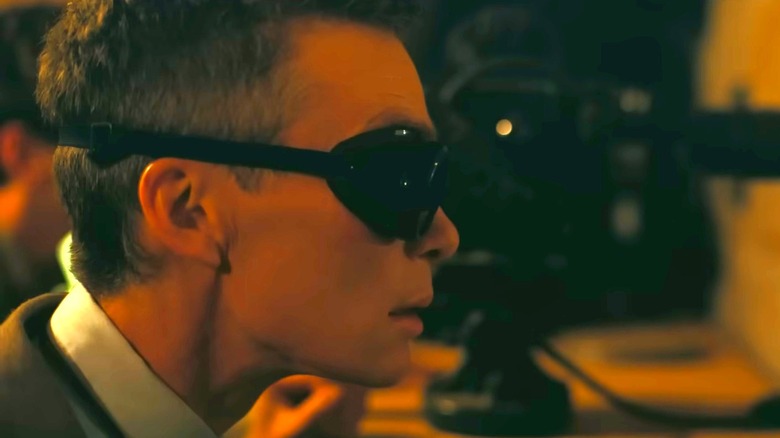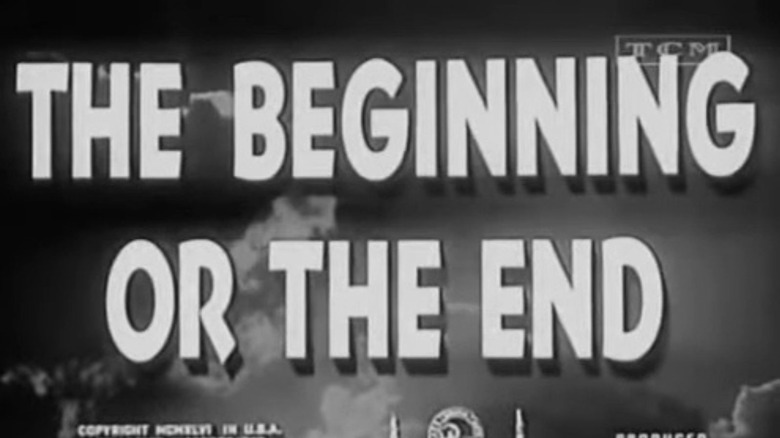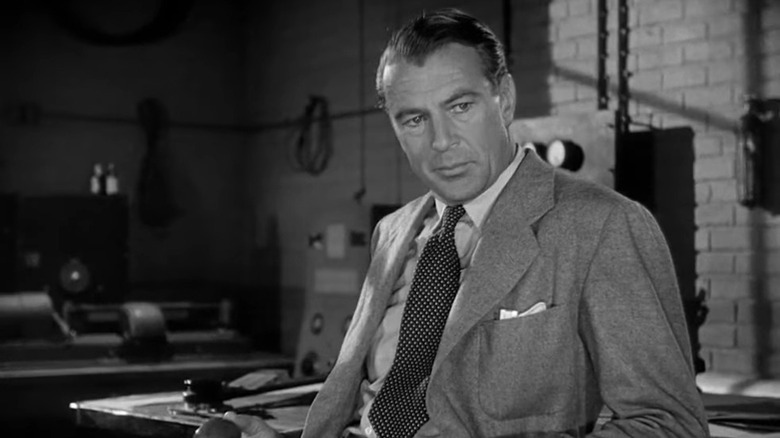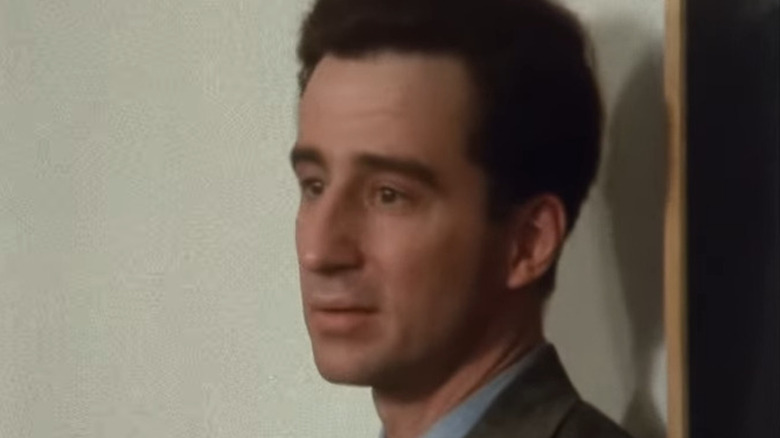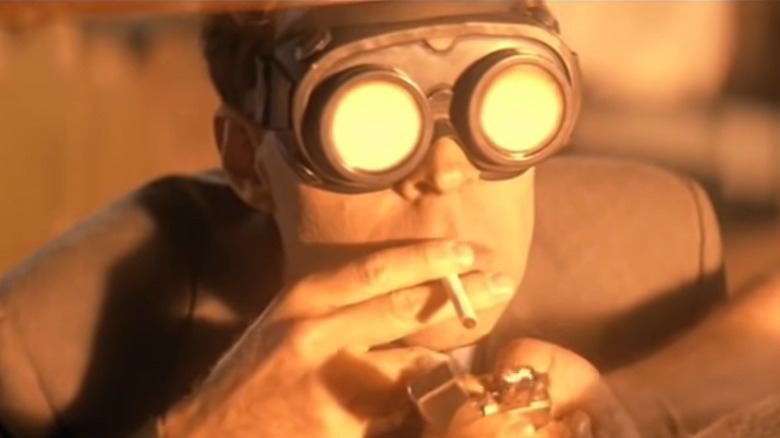Hollywood's Bizarre & Decades-Long Journey To Make An Oppenheimer Film Explained
It is October 1945. Two months earlier, America dropped a pair of nuclear bombs on the island nation of Japan, claiming hundreds of thousands of lives. Now, they want to make a movie about it.
Long before Christopher Nolan would bring about the deeply personal yet almost pre-apocalyptic political horror film "Oppenheimer," Hollywood and the American government had very different ideas about how to tell the story of the invention of mankind's deadliest weapon. Studios, filmmakers, philosophers, military officers, scientists, and even a U.S. president came together — and at times competed — to create a definitive dramatization of the historic moment. Some involved themselves to ensure its accuracy; others, its national loyalty.
Interested parties would spend the next 65 years trying to confront the Father of the Bomb through film, venturing slowly but surely beyond the safe distance of documentary to dangerously revealing dramatic works that betray the mindset of the creatives and culture that unleashed them on the world.
The first race to tell Oppenheimer's story began in 1945
In the direct aftermath of the "successful" bombings of Hiroshima and Nagasaki, there was a swift race in Hollywood to be the first studio to chronicle the drama surrounding the Manhattan Project. It is generally agreed that this race began when Edward R. Tompkins (a chemist who worked at the project's Oak Ridge, Tennessee facility) approached his former student, Donna Reed, (a celebrated actor and future star of "It's a Wonderful Life") with the idea of producing a film following the morally-conflicted scientists working on the atomic bomb. Reed took this idea to her husband, MGM producer Tony Owens. He then took it to President Harry Truman, who encouraged them to proceed with his blessing and provided the title "The Beginning or the End."
At the same time, independent producer Hal B. Wallis ("Casablanca") tapped writer and philosopher Ayn Rand to pen her own film about the happenings at Los Alamos for Paramount Pictures. Rand threw herself into the work, curiously interpreting the Manhattan Project as a testament to free market capitalism and individual free will. Though she nabbed two rare interviews with J. Robert Oppenheimer himself, her film, titled "Top Secret," barely made it past the treatment stage (a dense, proselytizing document by all accounts) before Wallis brought in another writer and, eventually, sold his and Rand's work to MGM for their use.
MGM was able to move forward uncontested — at least, they thought they would. The title wasn't the last thing the American government gave "The Beginning or the End." The final product was so full of jingoistic revisionism and scientific inaccuracies that many of the real-life figures involved — including Tompkins and Niels Bohr (played by Kenneth Branagh in Nolan's film) — publicly denounced it before its March 7, 1947 release.
Gary Cooper played a James Bond-esque Oppenheimer analog
In the middle of the Paramount-MGM atomic race, producer Milton Sperling and his company, United States Pictures, developed a more blatantly fictionalized film with ties to the Manhattan Project. Loosely based on the World War II-era memoir of OSS agents Lt. Colonel Corey Ford and Major Alistair MacBain, released in January 1946, "Cloak and Dagger" told the story of a fictional yet seemingly Oppenheimer-inspired scientist named Alvah Jesper.
"Cloak and Dagger" is perhaps the most flattering (at least, by some standards) depiction of the Manhattan Project and its leading scientists. Though he was a nuclear physicist employed on the project, Alvah Jesper spends the majority of the film traveling around Europe doing clandestine intelligence work for the OSS — which apparently involves a fair amount of ... tactical seduction, shall we say? To complete the full picture of this unabashedly Hollywood affair, Jesper was played by none other than Gary Cooper, who is actually referenced by name in Christopher Nolan's "Oppenheimer" screenplay. (Describing Cillian Murphy's Oppenheimer returning to base camp after the Trinity Test in the first person, he writes: "I get out [of the car], walking like GARY F***ING COOPER — the crowd spots me... goes NUTS...")
Before it was released in September 1946, Sperling mandated that a controversial moment from the film be cut entirely: a sequence that suggested the U.S. could not keep its nuclear secrets forever. A year later, the screenwriters responsible for "Cloak and Dagger" — Albert Maltz and Ring Lardner Jr. — would have this scene held against them by anti-communist politicians and officials. They would be held in contempt of Congress (along with eight others, now known as the Hollywood Ten) for refusing to testify to the House Un-American Activities Committee.
As America retreated, the U.K. brought Oppenheimer to TV
The initial atomic gold rush in Hollywood proved mostly tepid. Of the two, "Cloak and Dagger" was the most successful, making distributor Warner Bros. $2.5 million domestically against a budget of $2.07 million. It was the 50th highest-grossing film of 1946 (for comparison, the 50th highest-grossing film of 2019 was, coincidentally, the World War II drama "Midway" with $56.2 million domestically).
In the following decades, the industry would deal with the Manhattan Project sparsely and almost exclusively in the form of documentaries. However, in 1980, the BBC produced a television miniseries called "Oppenheimer," featuring "Law and Order" star Sam Waterson in the title role. Christopher Nolan (who was raised in the U.K.) was 10 years old at the time — just one year from declaring himself a future filmmaker.
"Oppenheimer" (1980) won numerous accolades at the 34th annual BAFTA Television Awards ceremony, including best drama. It follows many of the same figures depicted in Nolan's film and similarly chronicles the scientist's journey from Manhattan Project director to persecuted public figure.
1989's Fat Man and Little Boy was the last serious attempt before Christopher Nolan's Oppenheimer
America would come back around to the Manhattan Project with 1989's "Fat Man and Little Boy," taking a more direct approach to historical events closer in line with both "Oppenheimer" (1980) and Christopher Nolan's 2023 film of the same name. While J. Robert Oppenheimer does appear as a major character (played by Dwight Schultz), its true star was arguably Paul Newman's Leslie Groves (Matt Damon's gruff U.S. general from the 2023 film).
"Fat Man and Little Boy" kept its story mostly contained to the operations at Los Alamos and the tension between Groves and Oppenheimer as they tried to complete their work without compromising security. It was poorly received by contemporary critics, who largely felt it minimized or otherwise misunderstood the actual drama that took place throughout the Manhattan Project's operation. It made just $3.5 million at the domestic box office.
Aside from a CBS made-for-TV movie released in the same year, "Fat Man and Little Boy" would be Hollywood's last serious engagement with J. Robert Oppenheimer until 2023. Worldwide, Nolan's "Oppenheimer" has grossed over $648 million and has received near-unanimous critical acclaim, arguably making it the most successful film about the scientist — and his deadly invention — in over six decades of attempts.
